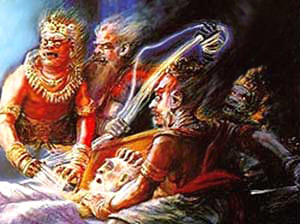Dutas are messengers. They are also known as Gananatas. Dutas are divided into three classes called, Shiva dutas, Vishnu dutas and Yama dutas.
The Shiva dutas are represented as red, short, and thick like the Bhuta. Their hair-locks remain twisted together, rest on their heads like a cap and two great lion`s teeth come out from their mouths. The Shiva dutas have four hands in which they hold a snake, a cord, a trident and a wine-jug. The body of the Shiva dutas is adorned with various ornaments. It is said that Iswara obtains the souls of his devotees at their death to his seat of bliss called Kailasa with the help of these Shiva Dutas. The souls are carried by Pushpaka vimana, a self-moving chariot.
The Vishnu dutas have their hair dressed like the Shiva dutas. They also have a lion`s teeth like the Shiva dutas but otherwise they resemble Lord Vishnu. They look like Vishnu because of their blue body colour and they wear the Tirunama on their forehead, arms, and breasts like Vishnu. Like Vishnu, the Vishnu dutas also hold a Shankha, a Chakra, a battle-axe and a club in their four hands, respectively. Through these dutas, Vishnu fetches the souls of his faithful devotees into his abode of bliss called Vaikuntha.
 The Yama dutas or the messengers of Yama, the king of death and hell are painted quite black like demons with horrible faces and great teeth. The Yama dutas carry a trident, a club and many ropes in their four hands and they carry daggers in their girdles. The Yama dutas carry the souls of the wicked into Naraka or hell. But, they are not allowed to touch anybody before his or her fixed lifetime is elapsed. These dutas also cannot touch the pious souls.
The Yama dutas or the messengers of Yama, the king of death and hell are painted quite black like demons with horrible faces and great teeth. The Yama dutas carry a trident, a club and many ropes in their four hands and they carry daggers in their girdles. The Yama dutas carry the souls of the wicked into Naraka or hell. But, they are not allowed to touch anybody before his or her fixed lifetime is elapsed. These dutas also cannot touch the pious souls.
But, when a person dies, who is neither virtuous nor wicked, then the messengers of Yama and those of Shiva or Vishnu come into conflict with each other, each party claiming the indifferent souls.



















